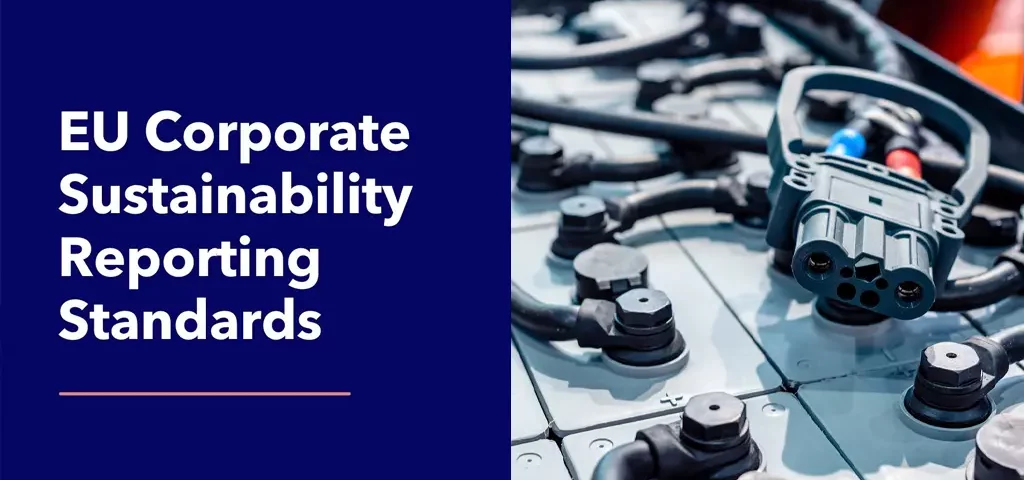
Tahiti: a cutting-edge solution to the ecological transition challenges in French Polynesia
5 September 2024
Securing the regeneration of lithium batteries: Be Energy unveils the PTS 800 at CES 2025 in Las Vegas
27 March 2025
January 2024 marked a decisive turning point for European companies with the advent of the CSRD (Corporate Sustainability Reporting Directive). This new regulation, which succeeds the NFRD (Non-Financial Reporting Directive), considerably broadens the scope of environmental, social and governance (ESG) transparency requirements. From now on, not 11,000, but more than 50,000 entities will be required to report on their sustainable performance.
At the heart of this transformation are the European Sustainability Reporting Standards (ESRS), the pillars of the CSRD. These standards aim to standardise and strengthen reporting practices, thereby placing sustainable development at the heart of companies' strategic concerns.
The CSRD introduces an innovative concept: dual materiality analysis. This approach requires companies to consider not only the influence of their environment on their financial results, but also the footprint of their activities on society and the surrounding ecosystem.
Against this backdrop of regulatory change, initiatives such as battery regeneration, developed by Be Energy, are emerging as concrete solutions. These innovations are perfectly aligned with the ESRS criteria while contributing to the development of a circular economy, thus responding to the challenges posed by CSRD in a pragmatic and visionary way.
ESRS standards: a new paradigm for corporate responsibility
July 2023 saw the adoption of the ESRS standards by the European Commission, marking the start of a new era in corporate reporting. Coming into force in January 2024, these standards revolutionise the way organisations understand and communicate their ESG (Environmental, Social and Governance) impact.
This innovative framework is built around three fundamental pillars:
1. The environmental dimension, which addresses crucial issues such as combating climate change, reducing pollution, preserving biodiversity and promoting the circular economy.
2. The social dimension, which focuses on respect for human rights, improving working conditions and assessing the impact of activities on local communities.
3. The governance dimension, which examines managerial practices, with particular emphasis on the transparency and accountability of management bodies.
At the heart of this system is the concept of dual materiality analysis, the cornerstone of the ESRS standards. This innovative approach invites companies to take an in-depth look at two key issues:
· Firstly, how do the challenges of sustainable development, such as climate change, affect their financial health?
· Secondly, what is the real footprint of their activities on the environment and the social fabric?
This approach requires companies to demonstrate, for each issue addressed, its relevance or lack of relevance through a rigorous materiality analysis. Far from being a mere formality, this requirement pushes organisations to meticulously justify any omission of a subject deemed irrelevant, thereby reinforcing the rigour and credibility of their reporting.
Battery regeneration: an innovation at the heart of ESRS requirements
The year 2023 marked a turning point in the battery industry with the opening in Avignon of the world's first plant dedicated to battery regeneration by Be Energy. This technological advance, which aims to extend the life of used batteries while improving their performance, is perfectly aligned with the objectives of the ESRS standards, particularly in terms of the environment and the circular economy.
A triple positive impact
1. Reduced carbon footprint: Battery regeneration is remarkably environmentally efficient. For every tonne of battery processed, this process saves around three tonnes of CO2 compared with traditional recycling. This impressive performance directly meets the environmental reporting requirements of the ESRS, putting Be Energy at the forefront of the fight against climate change.
2. Spearheading the circular economy: By giving batteries a second life, Be Energy embodies the very essence of the circular economy advocated by the ESRS. This innovative approach not only significantly extends the useful life of batteries, but also tackles head-on the problem of programmed obsolescence, a key issue of our time.
3. Exemplary transparency and traceability: Be Energy's innovation goes beyond simple regeneration. Thanks to its Riverse certification, the company can now sell carbon credits on the voluntary market, offering double added value. What's more, each regeneration process ends with the publication of a detailed carbon report, guaranteeing total transparency and verifiability of the data, in full compliance with ESRS requirements.
A concrete solution for a sustainable future
Be Energy is demonstrating that battery regeneration is not simply a response to the regulatory requirements of the CSRD and ESRS standards. It represents a genuine revolution in the way companies manage their environmental impact. By doubling the lifespan of batteries and offering a process that is 50 to 70 times less carbon-intensive than conventional recycling, Be Energy is paving the way for a greener, more sustainable economy.
This innovative approach not only reduces the carbon footprint; it also generates carbon credits, giving companies additional leverage to achieve their sustainability goals. Be Energy proves that technological innovation can go hand in hand with environmental responsibility, while creating economic value.
CSRD and ESRS: catalysts for innovation and transformation
The advent of CSRD and ESRS standards marks a decisive turning point for companies, forcing them to rethink their practices through the prism of sustainability. Battery regeneration, while offering a promising solution, also raises unprecedented challenges.
The challenge of measurement: quantifying the impact so that it can be better exploited
One of the major challenges facing companies is the precise and verifiable quantification of the environmental benefits associated with battery regeneration. This is essential if they are to fully integrate this practice into their ESRS reporting and demonstrate its positive impact in a tangible way.
A springboard to sustainable excellence
Despite these challenges, the adoption of battery regeneration opens up considerable opportunities:
1. Enhanced regulatory compliance: By integrating battery regeneration into their strategy, companies are doing more than just meeting the requirements of the WEEE Directive; they are establishing themselves as pioneers of the circular economy and anticipating future regulatory developments.
2. Invaluable reputational leverage: Committing to sustainable practices such as battery regeneration enables companies to strengthen their corporate social responsibility (CSR). This approach not only attracts environmentally conscious investors, but also positions the company as a key player in the energy transition.
3. Significant economic optimisation: In addition to its ecological impact, battery regeneration represents a real economic advantage. By doubling the lifespan of equipment, it considerably reduces operating costs. This optimisation of resources offers an undeniable competitive advantage, particularly in sectors where efficiency is paramount.
A step towards a sustainable future
Battery regeneration goes beyond simple technological innovation to become a concrete, multi-dimensional response to the requirements of the CSRD and ESRS standards. By adopting such practices, companies are taking a holistic approach to improving their environmental, social and financial performance.
At a time when sustainability is emerging as the new economic paradigm, battery regeneration represents a unique opportunity for companies to position themselves at the forefront of the ecological transition. It offers a concrete model for reconciling economic imperatives with environmental responsibility, paving the way for a future where performance and sustainability go hand in hand.
By embracing these new practices, businesses are preparing themselves to face tomorrow's challenges and are giving themselves the means to transform them into opportunities for growth and innovation, thereby redefining the contours of a more resilient economy that respects our planet.


